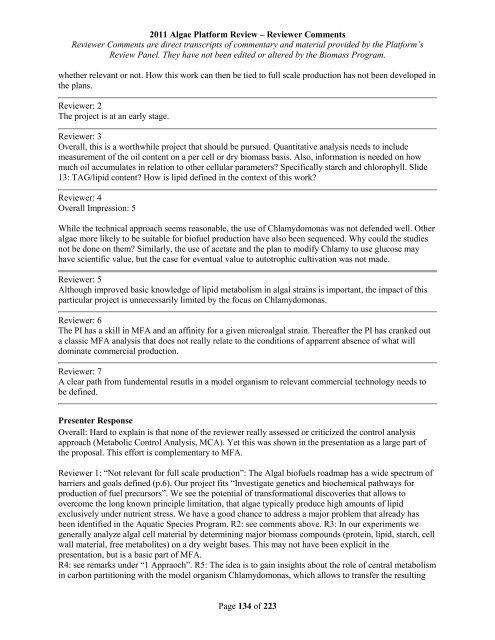Reviewer Comments - EERE
Reviewer Comments - EERE
Reviewer Comments - EERE
You also want an ePaper? Increase the reach of your titles
YUMPU automatically turns print PDFs into web optimized ePapers that Google loves.
2011 Algae Platform Review – <strong>Reviewer</strong> <strong>Comments</strong><br />
<strong>Reviewer</strong> <strong>Comments</strong> are direct transcripts of commentary and material provided by the Platform’s<br />
Review Panel. They have not been edited or altered by the Biomass Program.<br />
whether relevant or not. How this work can then be tied to full scale production has not been developed in<br />
the plans.<br />
<strong>Reviewer</strong>: 2<br />
The project is at an early stage.<br />
<strong>Reviewer</strong>: 3<br />
Overall, this is a worthwhile project that should be pursued. Quantitative analysis needs to include<br />
measurement of the oil content on a per cell or dry biomass basis. Also, information is needed on how<br />
much oil accumulates in relation to other cellular parameters? Specifically starch and chlorophyll. Slide<br />
13: TAG/lipid content? How is lipid defined in the context of this work?<br />
<strong>Reviewer</strong>: 4<br />
Overall Impression: 5<br />
While the technical approach seems reasonable, the use of Chlamydomonas was not defended well. Other<br />
algae more likely to be suitable for biofuel production have also been sequenced. Why could the studies<br />
not be done on them? Similarly, the use of acetate and the plan to modify Chlamy to use glucose may<br />
have scientific value, but the case for eventual value to autotrophic cultivation was not made.<br />
<strong>Reviewer</strong>: 5<br />
Although improved basic knowledge of lipid metabolism in algal strains is important, the impact of this<br />
particular project is unnecessarily limited by the focus on Chlamydomonas.<br />
<strong>Reviewer</strong>: 6<br />
The PI has a skill in MFA and an affinity for a given microalgal strain. Thereafter the PI has cranked out<br />
a classic MFA analysis that does not really relate to the conditions of apparrent absence of what will<br />
dominate commercial production.<br />
<strong>Reviewer</strong>: 7<br />
A clear path from fundemental resutls in a model organism to relevant commercial technology needs to<br />
be defined.<br />
Presenter Response<br />
Overall: Hard to explain is that none of the reviewer really assessed or criticized the control analysis<br />
approach (Metabolic Control Analysis, MCA). Yet this was shown in the presentation as a large part of<br />
the proposal. This effort is complementary to MFA.<br />
<strong>Reviewer</strong> 1: “Not relevant for full scale production”: The Algal biofuels roadmap has a wide spectrum of<br />
barriers and goals defined (p.6). Our project fits “Investigate genetics and biochemical pathways for<br />
production of fuel precursors”. We see the potential of transformational discoveries that allows to<br />
overcome the long known principle limitation, that algae typically produce high amounts of lipid<br />
exclusively under nutrient stress. We have a good chance to address a major problem that already has<br />
been identified in the Aquatic Species Program. R2: see comments above. R3: In our experiments we<br />
generally analyze algal cell material by determining major biomass compounds (protein, lipid, starch, cell<br />
wall material, free metabolites) on a dry weight bases. This may not have been explicit in the<br />
presentation, but is a basic part of MFA.<br />
R4: see remarks under “1 Appraoch”. R5: The idea is to gain insights about the role of central metabolism<br />
in carbon partitioning with the model organism Chlamydomonas, which allows to transfer the resulting<br />
Page 134 of 223




